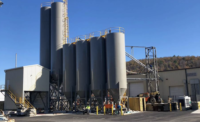The General Services Administration is rolling out a pilot program for new requirements for procuring significantly lower-embodied carbon construction materials, such as concrete and steel, for federal buildings projects funded by the Inflation Reduction Act.
The test program, which GSA announced on May 16, draws from the Inflation Reduction Act, enacted Aug. 16, also known as the Climate Act. The statute provides $2.15 billion for GSA to use low-embodied carbon materials for its federal buildings projects.
The agency says the pilot program will help it meet President Joe Biden’s goals of having a net-zero emissions portfolio of buildings by 2045 and net-zero emissions federal procurement by 2050.
The test program will take effect immediately, and extend for six months, GSA said.
The 11 projects chosen for the pilot are located in eight states and the District of Columbia. They also are at various stages of development and of varied types, including land port of entry modernizations and paving.
The total estimated value of the projects’ low embodied carbon is more than $300 million, according to GSA.
Program Covers 11 Projects
Among the new construction projects chosen for the program are; a land port of entry—or border station—at San Luiz, Ariz.; a Health and Human Services Dept.-Food and Drug Administration laboratory in Lakewood, Colo.; the Cybersecurity and Infrastructure Security Agency’s headquarters at its St. Elizabeths campus in Washington, D.C.; and the land port of entry in Dunseith, N.D.
Also on the list are: renovation of a federal building's garage in Detroit; facade upgrades at a federal courthouse in Kansas City, Mo.; rehabilitation of the Alexander Hamilton U.S. Custom House in New York City; and window replacement at a federal courthouse in Richmond, Va.
There also are three paving projects included, all in Texas—at the World Trade Bridge Land Port of Entry in Laredo; the Kika de la Garza Land Port of Entry in Pharr; and the land port of entry in Ysleta.
The pilot program is also part of the Biden administration’s “Buy Clean” initiative, which aims to use the purchasing power of the federal government to promote use of low-carbon materials, according to the White House Council on Environmental Quality. The council says that the federal government is the largest purchaser in the world, with purchasing power of more than $650 billion.
GSA said that the pilot program is a signal to manufacturers that it requires Environmental Product Declarations, or EPDs, for materials procured with Climate Act funding.
The agency noted that some types of products, such as hollow structural sections and structural steel plate produced by integrated steel mills, do not yet have published EPDs.
It added that the new pilot will provide more time for manufacturers to collect such data.
GSA said the test program implements the Environmental Protection Agency’s interim determination, which sets the definition of “substantially lower” greenhouse gas emissions, based on the EPDs.
Environmental groups praised the GSA pilot program. Natasha Vidangos, the Environmental Defense Fund’s associate vice president for innovation and technology policy, said in a statement that the program “is a critical first step to develop markets for clean construction materials that will lower pollution and create U.S. jobs.”






Post a comment to this article
Report Abusive Comment